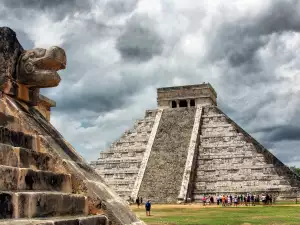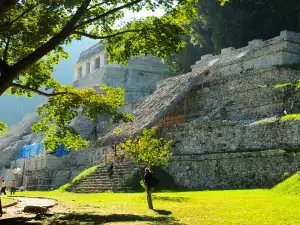Deep in the interior of China, near the ancient capital of Xi'an are a series of pyramid mounds almost unknown outside the country.
The interest in Chinese pyramids significantly increased in 1994 with the publication of the book White Pyramid by Hartvig Hausdorff. He briefly describes his travels through China in search of the legendary great white pyramid.

The initial source of the allegations of the existence of the white pyramid came from a book by Bruce Cathy "Bridge to Eternity" (1983), Bruce Cathy tells the story of the pilots in the U.S. Air Force James Guzmán. During World War II Guzmán was on a routine mission and flew between India and China, where problems occurred in the engine, which forced him to descend to lower altitudes and then he noticed a huge pure white pyramid as if it was made of crystal.
Another story tells of Colonel Morris Shian, director for the Far East of the Trans World Airline, who also claimed to have seen the white pyramid which he describes, makes the pyramids in Egypt look like dwarfs, namely one with a height of 1000 feet and 1500 feet wide. Shian determines the location of the pyramid at the end of a long inaccessible valley in the foothills of the Kin Ling Mountains about 40 miles southwest of Xian. He recalls that there is another smaller pyramid at the end of the valley where there are hundreds of small burial mounds.
In response to the mystery of where the white pyramid is exactly satellite images were thoroughly examined and structural formations were formed in the appropriate place to Xian.
One of the largest pyramids, visible on satellite images and in the region of Xian Maoling and although covered to some extent by the crowns of young trees is still an impressive sight. In its vicinity are small burial mounds of various shapes and configurations.
Unlike Pyramids of Egypt with their carefully carved and fitted stones, Maoling mausoleum is composed of tightly aggregated soil. It is the largest and most impressive of the 11 western imperial mausoleums and the place of death of Emperor Liu Qi, who reigned from 157-87 BC, it follows that tomb of over 2000 years. Chinese history tells that 53 years ere needed to build and fill the tomb with ts precious objects.
In close proximity are the gravestones of Emperor Qin Shi Huang, who unites the country in 221 BC. The story tells that all the craftsmen who worked on the construction of the tomb were killed to protect a secret, which to this day remains unsolved.
It is believed that the mausoleum of Qin Shi Huang was almost 330 feet high, but over time has eroded to 150 feet. From north to south, the gravestone is nearly 1700 feet long and from east to west the length is just under 1600 feet. These measures go beyond the measures of the Great Pyramid in Egypt.
Because the tomb of the Qin Shi Huang is slightly inclined in the country and further distorted by tightly covering trees the Maoling mausoleum is more impressive than the two others.









